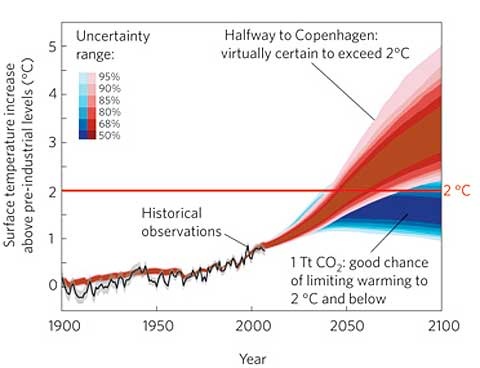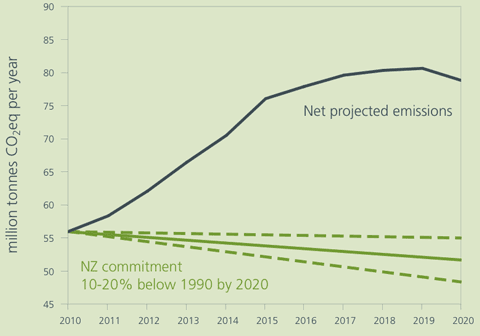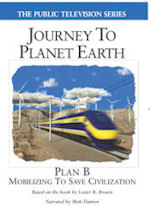 At the Climate Futures Forum in Wellington a couple of weeks ago, David Karoly discussed the idea of considering carbon emissions as a “stock” problem, not a “flow” problem. If we want to give ourselves a 75 percent chance of coming in below a 2ºC rise in the global average temperature, then we (as in all humanity) can emit around one trillion tonnes of CO2 (for more see Meinshausen et al here, discussed in the context of emissions targets at HT in this post). It doesn’t much matter when we do the emitting, because CO2 hangs around in the atmosphere for a long time, but stick to that limit we must if we’re serious about avoiding damaging warming. I like that way of thinking about the issue, as I noted in my report on the Forum, but it seems that I may have been rather optimistic about the height of the ceiling we’re living under, and our chances of hitting a 2ºC target. A new study by a team of Canadian climate modellers, Arora et al, Carbon emission limits required to satisfy future representative concentration pathways of greenhouse gases in Geophysical Research Letters, 38 (5) DOI: 10.1029/2010GL046270 (pdf here), suggests that:
At the Climate Futures Forum in Wellington a couple of weeks ago, David Karoly discussed the idea of considering carbon emissions as a “stock” problem, not a “flow” problem. If we want to give ourselves a 75 percent chance of coming in below a 2ºC rise in the global average temperature, then we (as in all humanity) can emit around one trillion tonnes of CO2 (for more see Meinshausen et al here, discussed in the context of emissions targets at HT in this post). It doesn’t much matter when we do the emitting, because CO2 hangs around in the atmosphere for a long time, but stick to that limit we must if we’re serious about avoiding damaging warming. I like that way of thinking about the issue, as I noted in my report on the Forum, but it seems that I may have been rather optimistic about the height of the ceiling we’re living under, and our chances of hitting a 2ºC target. A new study by a team of Canadian climate modellers, Arora et al, Carbon emission limits required to satisfy future representative concentration pathways of greenhouse gases in Geophysical Research Letters, 38 (5) DOI: 10.1029/2010GL046270 (pdf here), suggests that:
…we have already surpassed the cumulative emission limit and so emissions must ramp down to zero immediately. The unprecedented reduction in fossil‐fuel emissions implied by either of these scenarios suggests that it is unlikely that warming can be limited to the 2°C target agreed to in the 2009 Copenhagen Accord.
Bugger.

 Dr Jan Wright, New Zealand’s
Dr Jan Wright, New Zealand’s 
 When I was
When I was  I’ve just sent my submission on the NZ government’s intention to make a formal commitment to a
I’ve just sent my submission on the NZ government’s intention to make a formal commitment to a